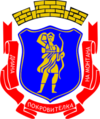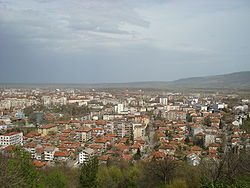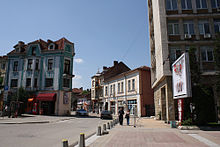- Montana, Bulgaria
-
Montana
МонтанаPanoramic view of Montana 
SealLocation of Montana, Bulgaria Coordinates: 43°25′N 23°14′E / 43.417°N 23.233°ECoordinates: 43°25′N 23°14′E / 43.417°N 23.233°E Country Bulgaria Province
(Oblast)Montana Government – Mayor Zlatko Zhivkov Elevation 135 m (443 ft) Population (Census February 2011)[1] – City 43,324 – Urban 53,247 Time zone EET (UTC+2) – Summer (DST) EEST (UTC+3) Postal Code 3400 Area code(s) 096 Montana (Bulgarian: Монтана) is a city in northwestern Bulgaria, located 50 km south of Danube river, 40 km northwest of Vratsa and 30 km east of the Serbian border. It is the administrative centre of the homonymous Montana Province. As of February 2011, the town has a population of 43,324 inhabitants.[1]
Contents
Names
When the town was first settled by Slavs it was known as Kutlovitsa; later in Ottoman Turkish as Kutlofça. The town was renamed Ferdinand in 1890, receiving the benevolence of Bulgarian Knyaz Ferdinand and a city status. In 1945, communist authorities changed the town's name to Hristo Mihaylov after red party activist Hristo Mihaylov (died 1944), a leader of the 1923 September Uprising in the region. A year later the name was changed to Mihaylovgrad. In 1993, after a presidential decree, the town received the name Montana, inspired by the name of the nearby Roman settlement.[2]
Geography
Montana is situated on the river Ogosta, north of Stara Planina, surrounded on the south and east by uplands.
The climate is temperate continental, with a cold winter and hot summer. The average temperature is -2°C in January and 25°C in July. In the last 15–20 years, temperatures reaching up to 35-40°C in the summer are not uncommon.
Population
The number of the residents of the city reached its peak in the period 1988-1991 when exceeded 55,000 with a highest rate in 1991 numbering 57,142.[3] The following table presents the change of the population after the World War II.
Montana Year 1887 1910 1934 1946 1956 1965 1975 1985 1992 2001 2005 2009 2011 Population ?? ?? ?? 8,049 13,399 27,040 40,197 51,714 52,397 49,176 46,866 45,350 43,324 Highest number 57,142 in 1991 Sources: National Statistical Institute,[1][3][4] „citypopulation.de“,[5] „pop-stat.mashke.org“,[6] Bulgarian Academy of Sciences[7] Elite High Scools
- Foreign Language HS "Petar Bogdan". Emphasis on English and German language proficiency. Recognized and praised for its scholars' academic accomplishments worldwide. http://gpchemont.com/sitegpche/
- Math and Science HS "St. Kliment Ohridski". Enhanced studies in math, biology, geography and foreign languages. Excellent development of talents and outstanding student performance. http://www.pmgmontana.com/pmgsite/
Entertainment
- Drama Theater "Dragomit Asenov" located at 1 Zheravitza Sq, Montana, BG 3400
- Piano Bar "Retro" located at 59 Third Blvd, Montana, BG 3400
- Night Club "Black Label" located in the heart of downtown
- Outdoor Swimming Pool & Bar "Augusta" sitting atop a hill by lake "Ogosta"
Lodging
- Hotel "Ring" Newly build by international standards. Offers panoramic view of the city and its surroundings along with passionate customer service. http://www.ring-hotel.com/en/
History
Roman times
The region around Montana became part of the Roman province of Upper Moesia in 29 BC. Around 160, the military camp that was most likely founded on the remains of an older Thracian settlement, acquired city rights under the name of Municipio Montanensium.The oldest part of town is the neighborhood at the foot of Montana mountain (hill). The city developed and urbanized after a Roman model and became the second most important settlement in the province after Raciaria (modern-day Archar). A fortress was built on top of the hill over Montana, as well as public and residential buildings, temples, baths and theatres. Montana became a typical imperial settlement, where the local romanized population coexisted along Italic and Anatolian settlers. The base of the town's economy were the big landowners of Italic origin and their villas and mansions, where the locals served to obtain agricultural production and gold from Ogosta's river valley. A stratum of Greek settlers, who engaged in craftsmanship and money-landing existed in the town during the period. The patrons of Montana in the spirit of Hellenism were Diana and Apollo.
Middle Ages
Between 440 and 490, the northwest of modern Bulgaria was devastated by the raids of the Huns under Attila and the Goths. Slavs and Avars delivered the final strike on the Greco-Roman culture in the region, and the Slavs that settled in the area called the town Kutlovitsa. During the time of the First and Second Bulgarian Empires, the settlement recovered and became the centre of an eparchy.
Ottoman rule
After Kutlovitsa was seized by the Ottomans, the settlement was destroyed and became deserted. It was renamed "Kutlofça" by the Ottomans, which was derived from Kutlovitsa. Between 1450 and 1688, the town was resettled by Turks because of its strategic location, and went through another period of blossoming as a typically Oriental town. A mosque, fountains, and other new buildings were erected. There was also a Roman Bath left over the Middle Ages.
Modern history
After the Liberation began a massive wave of migration towards Kutlovitsa and a period of economic blossoming. An electric station, a train station, a post office and a hospital were built, a fair and a community centre emerged. She has a football team, who named PFC Montana. PFC Montana was founded in 1921 and played in Bulgarian A Professional Football Group between 1994–1997 and 2009–present day.
Born in Montana
- Yordanka Blagoeva (1947-01-19) - World champion and record holder in high jump between September 24, 1972 and August 24, 1974
- Stiliyan Petrov (r. 1979) - Player in the national football team of Bulgaria and Aston Villa
- Yordan Radichkov-writer
- Stefan Savov (1896–1969) - playwright
- Nelly Rangelova (r. 1958) - Bulgarian pop-singer
- Dragomir Asenov (1926–1981) - playwright
- Rosalin Nakov (1965) - Composer
- Elen Koleva ( March 31, 1984) - actress
- Ognyan Nikolov-opera singer
International relations
Twin towns — Sister cities
Montana is twinned with:
 Banská Bystrica, Slovakia
Banská Bystrica, Slovakia Zhytomyr, Ukraine
Zhytomyr, Ukraine Schmalkalden, Germany
Schmalkalden, Germany Pirot, Serbia
Pirot, Serbia Salvatierra/Agurain, Spain
Salvatierra/Agurain, Spain Dzerzhinsky (town), Russia
Dzerzhinsky (town), Russia Kassel, Germany
Kassel, Germany Surakarta, Indonesia.[8]
Surakarta, Indonesia.[8]
Honour
Montana Bluff on Livingston Island in the South Shetland Islands, Antarctica is named after the city of Montana.
Districts
- Central
- Mladost 1 and 2 - large residential district in the northwestern part of the town composed of about 40, built in the 80's, blocks of flats.
- Pliska
- Pastrina
- Mala Kutlovitsa - suburban district composed mainly of residential houses
- Izgrev
- Kosharnik - rundown neighbourhood on the outskirts of the town populated mainly with Roma Gypsies.
- Ogosta
- Zhivovtsi
- Industrial Zone
- Bodur Mahala (unofficial name)
- Barcelon mahala (unofficial name)
Gallery
References
- ^ a b c (Bulgarian)National Statistical Institute - Main Towns Census 2011
- ^ Rough Guide to Bulgaria (2008) ISBN 978 1 85828 068 4 p.182
- ^ a b (Bulgarian)National Statistical Institute - Towns population 1956-1992
- ^ (English) Bulgarian National Statistical Institute - towns in 2009
- ^ (English) „WorldCityPopulation“
- ^ „pop-stat.mashke.org“
- ^ (Bulgarian) Bulgarian Academy of Sciences
- ^ "Surakarta dan Montana, Bulgaria Menjadi Kota Kembar". Portal Nasional Republik Indonesia. October 21, 2007. http://www.indonesia.go.id/id/index.php?option=com_content&task=view&id=3384&Itemid=683. Retrieved 2010-01-25.
External links
Berkovitsa · Boychinovtsi · Brusartsi · Chiprovtsi · Georgi Damyanovo · Lom · Medkovets · Montana · Valchedram · Varshets · Yakimovo
Categories:- Populated places in Bulgaria
- Montana Province
- 100 Tourist Sites of Bulgaria
- Montana, Bulgaria
Wikimedia Foundation. 2010.













